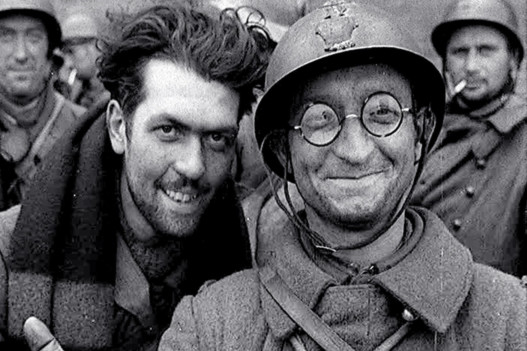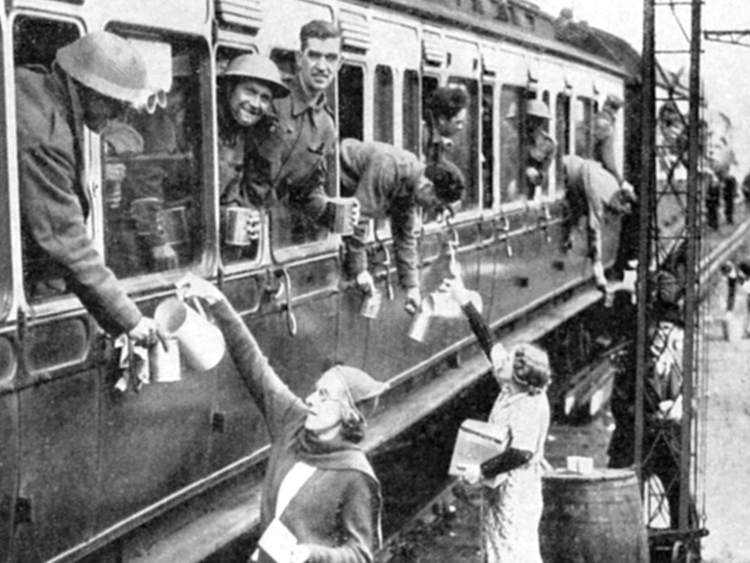
The Second World War movie lasts less than two hours. The heroic rescue mission went on for days.
British 2nd Lt. P.D. Elliman had escaped from the German onslaught in a driving rain. He and his men from the Royal Artillery had fled in a truck they were forced to abandon. Now, on the evening of May 29, 1940, they found themselves jammed with thousands of others on the beach at the northern French coastal town of Dunkirk.
Smoke from burning oil tanks drifted over the city. And German “Stuka” dive bombers, equipped with terrifying sirens, swooped overhead “like a flock of huge, infernal seagulls,” he wrote later.
Suddenly, one made for the spot where he and his men huddled.
“I heard (it) coming down in a vertical dive right on top of me,” he wrote, according to historian Hugh Sebag-Montefiore. “I was now dulled by hours... of explosions... so that the imminence of death aroused no great feeling of fear... The next moment: Crash! Darkness! And then a vision of falling sand... I realised I had been missed... I could hear the plane climbing away over Dunkirk.”
The Second World War drama that unfolded at Dunkirk — scarcely remembered by most Americans — is the subject of a new movie of the same name that opens this week. The product of British director Christopher Nolan, it seeks to compress the eight days of tragedy, desperation and heroism into 107 frantic minutes.
The United States, which would not enter the Second World War for a year and a half, watched the Dunkirk calamity from the sidelines. For Americans, Pearl Harbor, Iwo Jima and D-Day would become the war’s memorable events.
But in Britain it still resonates powerfully.
“It showed the nation at its best,” Sebag-Montefiore wrote. “So many people from all walks of life (came) together to demonstrate that famous all-conquering spirit. Nearly every British family either has or had a relative or acquaintance who was there.”
Dunkirk was the evacuation site for 338,000 British and French troops who had fled the German army as it blitzed through Belgium and France in the opening months of the Second World War. The battered allied soldiers were pushed into a narrow seaside pocket where they were bombed and shelled, and awaited annihilation.
Britain expected only about 30,000 to be saved.
Instead, from May 26 to June 3, many more were rescued by 800 British warships, excursion boats, barges, lifeboats, tugboats, fishing trawlers, paddle steamers, a fire boat, and a Thames River “sludge hopper” that got them across the English Channel to safety.
In one case, echoed somewhat in the movie, a father and son sailed their yacht from Southampton to Dunkirk to help out, according to British maritime historian E. Keble Chatterton.
But the ships, too, braved air attacks, as well as artillery fire from shore, torpedoes, mines, and treacherous tides and weather.
Many of them, including a hospital ship whose demise is shown in the movie, never returned. Twenty five Royal Navy destroyers, along with roughly 150 other vessels were lost or damaged, according to Sebag-Montefiore’s book, Dunkirk, Fight to the Last Man.
“It was in conditions such as these that our men carried on,” British Prime Minister Winston Churchill told the House of Commons on June 4, 1940, four weeks after he had taken office. “With little or no rest, for days and nights on end... across the dangerous waters bringing with them always men whom they had rescued.”
The pity was that “so many of the small vessels, which disappeared into the Dunkirk haze, left no record behind them, and will never receive the thanks due to them,” Chatterton wrote in his 1940 book, The Epic of Dunkirk.
As Britain realised the magnitude of the German army’s victories in May 1940, it summoned and requisitioned boats of all kinds to help in the evacuation. Since many soldiers were congregated on the beach, shallow water boats were needed, along with bigger steamers that could carry more men.
Often, the bigger vessels would wait in deeper water while barges and rowboats went in to fetch men from the beach.
Vessels like the Constant Nymph, a motor yacht owned by a London doctor, made the journey. So did the Royal Daffodil, a new two-stack pleasure boat, and the elegant paddle steamer, Crested Eagle, whose bones still litter the Dunkirk beach.
The tug, St. Abbs, went, and did not come back. The doomed hospital ship, Paris, made six trips, and was bombed and machine gunned to the bottom on her last one. The excursion steamer, St. Seiriol, made seven trips, braved numerous air attacks, and rescued 900 men. But the strain was tremendous, and at one point a military doctor sent the master and crew home to rest, Chatterton wrote. Another crew took over.
Maj. Rupert Colvin, of the 2d Grenadier Guards, and his men were picked up by a motor launch towing some life boats. They headed for a nearby British destroyer, probably HMS Keith. But as they approached, the destroyer was attacked by enemy planes and fled as its men abandoned ship, according to Sebag-Montefiore.
Colvin, along with survivors from the Keith and a sunken British minesweeper, were taken aboard the St. Abbs. “Most of them were practically dead with cold” and covered in oil, Colvin recalled. One man wore a life jacket but had lost both arms below the elbow.
Then the St. Abbs was attacked by the German planes. The tug split in half and sank in 45 seconds. Colvin was thrown free.
“Men were now dying every moment from cramps, and their cries for help were pathetic,” he wrote. “It was the second time that day that many of these sailors had faced death by drowning. We were all very near the end of our tether.”
He was eventually picked up by yet another ship and was attacked again, but survived.
The doomed Crested Eagle was “one of the most beautifully designed hulls that ever used the Thames,” Chatterton wrote. The excursion steamer burst into flames when it was hit.
“Many men were seen to jump overboard, and as she grounded on the beach it was one white-hot mass that no power could put out,” he wrote. “Londoners will not easily forgive the Nazis for having destroyed the Crested Eagle.”
Dunkirk, the evacuation, closed, as does Dunkirk, the movie, with Churchill’s words.
“We shall go on to the end,” he said. “We shall defend our island whatever the cost may be. We shall fight on the beaches... We shall fight in the fields and in the streets. We shall fight in the hills. We shall never surrender.”















